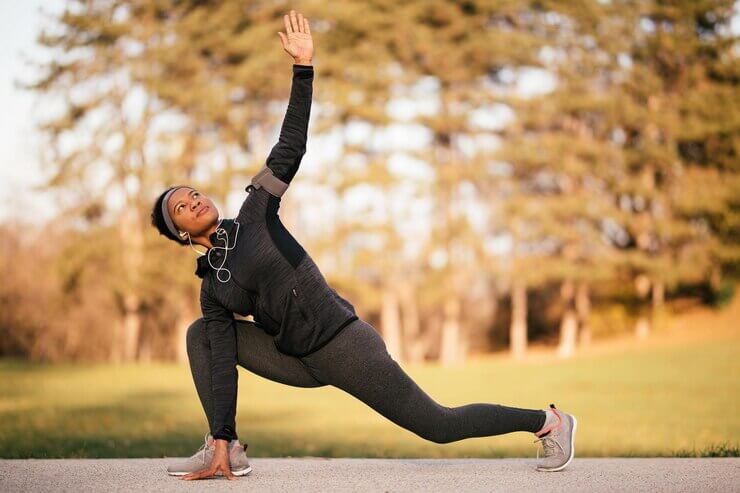Maintaining a healthy lifestyle amidst a busy schedule can indeed pose challenges. However, with effective strategies, efficient exercises for health and a commitment to prioritizing well-being, achieving optimal physical fitness is entirely feasible. In this concise guide, we provide you with practical strategies and best exercises for overall health to take care of your well-being and boost your physical fitness. Some of the key points highlighted below include: starting small and gradually increasing activity levels; finding enjoyable activities; having an exercise partner; and setting SMART fitness goals. It is also important to listen to one’s body, fuel workouts appropriately, and create a supportive environment. By embracing these strategies, you can enhance your energy levels, strengthen your mindset, and achieve lasting improvements in overall health.
Why Do We Need Exercises for a Healthy Lifestyle?
Regular exercise has been shown to positively impact mood and energy levels. Additionally, it could be associated with a range of significant health benefits, including a reduced risk of chronic diseases.
Exercise for beginners encompasses any physical activity that engages your muscles and promotes calorie burning. There are various forms of physical activity, such as walking, dancing, jogging, running, and swimming, that we will discuss below.
Image Source: Parkinson
Different Types of Exercises
To maximise the full benefits of exercise for beginners, experts advise doing a variety of different types of exercises for health, including:
Aerobic Exercise
Aerobic refers to a process that relies on the presence of oxygen. During aerobic exercise, your muscles are supplied with the necessary oxygen from your breath. This oxygen provides them with the energy required to perform their tasks.
Aerobic exercise is typically described as any form of sustained physical activity that engages large muscle groups for an extended period. There are various forms of aerobic activity, such as swimming, walking, jogging, cycling, dancing, and hiking.
Strength Training
You can choose from various exercises, such as bodyweight exercises, weight training with weights or resistance bands, or a combination of both. It may also incorporate Pilates workouts. To maintain optimal muscle, bone, and joint health, it is recommended to engage in muscle-strengthening activities twice a week.
In addition to enhancing muscle strength, strength training workouts offer numerous health benefits, including reducing the risk of developing conditions such as diabetes and heart disease. Furthermore, it is essential to prioritize exercise to maintain muscle mass and function as we age. As we get older, it’s crucial to maintain muscle-building workouts to combat sarcopenia, a condition that causes muscle deterioration over time.
HIIT (High-Intensity Interval Training)
This method is excellent for efficiently completing a high-intensity workout. Short recovery/rest intervals are incorporated between the high-intensity intervals in high-intensity interval training (HIIT). This type of training involves bursts of high-intensity exercises like cycling, squat leaps, or burpees. What makes it one of the best exercises for health is the fact that it continues to burn your calories long after you are done with your workout for the day.
A static bike workout can involve alternating between intense and relaxed cycling for short intervals, repeated multiple times. For added variation and challenge, consider incorporating different exercises, such as jump lunges or squat jumps, in between the hard cycling intervals!
Flexibility
Your flexibility level directly influences the range of motion in your muscles and joints. Enough flexibility is essential for daily activities, preventing injuries, and excelling in sports. There are two widely used forms of stretching: static and dynamic stretching. Static stretching involves holding a muscle stretch for an extended period. Dynamic stretching, in contrast, involves active stretches that simulate the upcoming workout.
Stretching is highly effective in improving the range of motion and boosting athletic performance. After a workout, it is expected to perform static stretching as it helps to increase muscle suppleness. On the other hand, dynamic stretching is recommended before physical activity to warm up the muscles effectively.
Image Source: Nia.Nih
Effective Strategies of Exercises for Health
Find Activities You Enjoy:
Discovering physical activities that you genuinely enjoy can make exercise feel less like a chore and more like a rewarding experience. Whether it’s dancing, hiking, or playing a sport, finding something that brings you joy increases the likelihood of sticking to your exercise routine long-term.
Start Small and Gradually Increase:
Begin your fitness journey with manageable goals and gradually increase intensity or duration as your strength and stamina improve. Starting small not only prevents burnout or injury but also builds confidence as you achieve each milestone, keeping you motivated to continue progressing.
Incorporate Variety:
Mixing up your workouts not only keeps things interesting but also ensures that different muscle groups are engaged and prevents plateaus in progress. From cardio and strength training to flexibility exercises and recreational activities, doing a variety of exercises for health not only challenges your body but also helps prevent boredom.
Buddy Up for Motivation:
Exercising with a friend or joining group classes can provide accountability and motivation. Having a workout buddy makes exercise more enjoyable and encourages healthy competition, pushing you to reach your fitness goals together.
Set SMART Fitness Goals:
Setting specific, measurable, achievable, relevant, and time-bound (SMART) fitness goals provides clarity and direction. Whether it’s aiming to run a certain distance, lift a specific weight, or improve flexibility, SMART goals help track progress and stay focused on what matters most.
Listen to Your Body’s Wisdom:
Paying attention to your body’s signals is crucial for preventing injuries and avoiding overtraining. Rest when needed, modify exercises if you experience discomfort, and prioritize recovery to ensure long-term health and sustainability in your fitness journey.
Fuel Your Workouts Right:
Eating a balanced diet with adequate nutrients fuels your body for optimal performance during workouts and aids in recovery afterward. Prioritize consuming complex carbohydrates for sustained energy, lean proteins for muscle repair, and healthy fats for overall well-being.
Track Your Exercise Journey:
Keeping a workout journal or using fitness tracking apps allows you to monitor progress, set new goals, and celebrate achievements along the way. Tracking your exercise journey provides valuable insights into what works best for you and helps maintain consistency in your routine.
Convenience is Key:
Choose exercises and activities that fit seamlessly into your lifestyle to remove barriers to consistency. Whether it’s finding a gym close to home, scheduling workouts during breaks at work, or incorporating physical activity into daily routines, prioritising convenience makes staying active more manageable.
Create a Supportive Environment:
Surround yourself with individuals who support your health and fitness goals, whether it’s friends, family, or online communities. Having a supportive environment fosters encouragement, accountability, and shared experiences, making it easier to stay committed to a healthy lifestyle.
What Other Factors Affect Healthy Lifestyle?
Image Source: Researchgate
Optimal Nutrition
Proper nutrition is essential for maintaining a healthy lifestyle. To achieve optimal performance, it is crucial to consume a well-rounded diet that includes whole grains, fruits, vegetables, lean meats, and healthy fats. Avoid excessive consumption of processed foods high in sugar, salt, and unhealthy fats, as this can lead to weight gain and chronic illnesses. For optimal nutrient intake, it’s helpful to plan your meals ahead of time and incorporate a variety of vibrant fruits and vegetables.
Regular Physical Activity
Staying physically active is crucial for maintaining overall health. Regular physical activity offers numerous benefits, including improved cardiovascular health, enhanced mood, strengthened muscles and bones, reduced risk of chronic diseases such as diabetes and hypertension, and assistance with weight management. Identify a physical activity that brings you joy, such as walking, cycling, dancing, or swimming. Aim to incorporate at least 150 minutes per week of moderate-intensity aerobic exercise into your routine.
Adequate Sleep
Sleeping is crucial for overall health, yet it is often overlooked. Lack of sleep can negatively impact the immune system, mood, and cognitive abilities. Additionally, it may increase the risk of developing chronic conditions such as diabetes and obesity.
Stress Management
Extended periods of stress can have detrimental effects on both the body and mind. It is crucial to establish effective strategies for managing stress to maintain a healthy lifestyle. Effective stress reduction methods encompass various practices such as deep breathing techniques, yoga, meditation, and engaging in hobbies.
Conclusion
In summary, adopting a healthy lifestyle is a journey that requires commitment and dedication, but the rewards are immeasurable. By incorporating effective exercise strategies into your routine, such as starting small, finding activities you enjoy, and setting SMART goals, you can pave the way for long-term success in enhancing physical fitness and overall well-being. Remember to listen to your body, fuel your workouts appropriately, and surround yourself with a supportive environment to stay motivated and accountable. Additionally, prioritise optimal nutrition, regular physical activity, adequate sleep, and stress management to complement your exercise regimen and achieve holistic health. By embracing these principles and seeking guidance from medical professionals when needed, you can embark on a transformative journey towards a healthier, happier you.
FAQs
The best exercises for overall health is a combination of aerobic exercise, strength training, and flexibility exercises to promote cardiovascular health, muscle strength, and joint mobility.
Walking stands out as the best exercise for life, offering numerous health benefits, accessibility, and low impact on joints, making it suitable for individuals of all ages and fitness levels.
While there’s no single “king” of all exercises, compound movements like squats, deadlifts, and push-ups are often considered foundational as they engage multiple muscle groups, promote strength and functional fitness, and yield significant overall health benefits.






